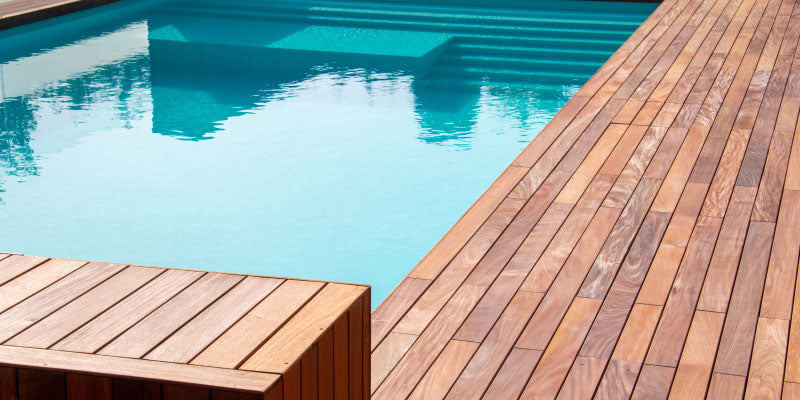
What is Ipe Hardwood Flooring?
|
|
Time to read 4 min
|
|
Time to read 4 min
Brazilian walnut, also known as Ipe, is a tropical hardwood grown primarily in Brazil but is also harvested in Bolivia, Venezuela, Guatemala, and Peru. Typically found in rainforests, the trees can grow to heights of 120 feet to 160 feet. The diameter of the tree ranges between three and six feet. Ipe is a popular choice for hardwood flooring because of its extreme durability and unique grain.
Botanical Name : Tabebuia serratifolia
Color: Brazilian walnut ranges in color from a light tan with greenish tinges to a brownish black.
Grain: The grain on the Brazilian walnut can be either fine and straight or very irregular.
Variations within Species and Grades: There is a large variation in color found in the Brazilian walnut,
however most pieces used for flooring tend to be of the darker variety.
Hardness/Janka: The Janka scale rating for Brazilian black walnut is 3,680.
Dimensional Stability: Brazilian black walnut has an average stability rating of 8.0.
Sawing/Machining: This lumber is very difficult to saw, especially if using hand tools.
Sanding: Sanding is very difficult and care must be given to minimize scratches and sanding marks.
Nailing: Because of the hardness of the lumber, Brazilian walnut can be very difficult to nail.
Finishing: Care should be given when finishing Brazilian walnut flooring.
Availability: Brazilian walnut is moderately available with some regional limitations.
Ipe, commonly referred to as Brazilian walnut, received its name from Native Americans in the region. The tree was valued not only for its beauty and durability, but also for the medicinal use of the bark. Although Brazilian walnut is increasingly becoming a popular choice for indoor flooring it has traditionally been used in much less forgiving settings. The lumber has been, and continues to be, a popular choice for decking, foot bridges, railroad crossties, tool handles, boardwalks, boat docks, and piers.
One of the most reliable indicators, in the flooring industry, of the durability of a specific type of lumber is its Janka scale rating. The Janka scale ranges from zero to 4,000. A rating near zero indicates that the wood is very soft and completely unsuitable as a flooring material. A rating of 4,000 is much too hard to be milled as a profitable flooring option. The Janka rating for Brazilian walnut is 3,680. This is one of the hardest and most durable flooring options available. Additionally, Brazilian walnut is very resistant to decay caused by fungus and to termite attacks, further adding to its value as decking choice. It can be used successfully in an outdoor setting without preservatives. This is an important consideration, as it reduces the harmful chemicals and pesticides that must be released into the environment in order to safeguard the lumber. The Brazilian walnut tree is also quite resistant to fire. It is a class A, according to the NFPA ranking, indicating it is as resistant to fire as concrete and steel.
Brazilian wood can be quite difficult to saw, and work with hand tools and is moderately difficult even with more modern options. Sanding this type of lumber is also difficult because of the density and the oily residue found on the wood. Scratches from processing are easily visible, and the sanding process must remove all scratches from the previous cut very carefully. Failure to do so will result in sanding marks and scratches that are visible after the lumber has been finished. Because of the density of the wood, it can also be quite difficult to nail. The preferred method is hand nailing, and pre-drilling the lumber may be required. Finally, all finishes should be tested prior to being applied to the flooring. Some finishes, such as those that are oil-modified, will require an extremely long time to dry. When working with Brazilian walnut, be aware that it can cause contact dermatitis in some individuals and may also cause some respiratory difficulties.
The high Janka scale rating of Brazilian walnut indicates that this type of flooring is perfect for areas that have high levels of foot traffic. The medium to dark color lend a sophisticated air to wherever the flooring is installed. It is quite well suited for office areas and other public buildings as well as homes. Unlike many other hardwood flooring options, this type of lumber is well suited to almost any area, including outdoor decking and bathrooms.
Even though Brazilian walnut is much more durable than most hardwood options, it is still important that routine care and maintenance be performed in order to keep the flooring looking beautiful. Although not absolutely necessary with flooring this durable, runners can be placed in high traffic areas to reduce the possibility of damage to the flooring. Pads should be placed under the feet of furniture to prevent indentions in the floor. These are hardly noticeable and are a good preventative measure, especially if the furniture is very heavy or likely to be moved at some point in the future. In addition to taking measures to prevent damage from daily use it is also important to have a regular cleaning schedule to optimize the longevity of the flooring. Floors should be swept or vacuumed on the hardwood setting routinely in order to remove the sand and grit that is tracked in on a daily basis. If allowed to accumulate, the sand and grit will scour the finish of the flooring over time and may eventually damage the wood underneath. It is much easier to maintain the finish than to have the flooring refinished after installation.
Because of the popularity of the durable lumber, the Brazilian walnut is becoming increasing difficult to find. The over harvesting of the species has made it increasingly difficult to find outside of forest reserves and national parks. Because of the reduced availability, it is important to make sure that flooring comes from a sustainable source and is not being harvested illegally.